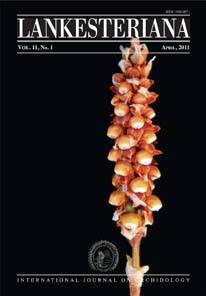Conservation of Madagascar’s granite outcrop orchids: the influence of fire and moisture
DOI:
https://doi.org/10.15517/lank.v11i1.18315Keywords:
conservation, inselberg de granit, Le Madagascar, Orchidaceae, Angraecinae, HabenariinaeAbstract
Is there a difference in response to disturbance, or resource limitation, by similar taxa based on micro-site habitat heterogeneity? For this study we examined how fire and moisture availability influences the distribution of terrestrial and lithophytic orchids specific to Madagascar’s granite outcrops (inselbergs). We compared orchid density in an area with a complex mosaic of burned and non-burned vegetation patches (three years after the event). Lithophytic species (subtribe Angraecinae) were sensitive to fire, but tolerant of limited moisture availability, and had a uniform distribution pattern associated with vegetation mat size. In contrast, most terrestrial species (subtribe Habenariinae) were not impacted by fire, but were limited to slopes with high water seepage, and had a clumped distribution pattern. The results suggest varying ecological niches between orchid subtribes, and among species, occurring on shared substrate. Within the larger area, we also compared three inselbergs with different fire disturbance history. One site with potential for lightning based fires, but absence of anthropogenic fires, had the greatest diversity (subtribes, genera, and species) of orchids and the highest occurrence of species restricted to a single site. For land management purposes it is inappropriate to assume that inselberg specific orchids will have the same response to environmental stressors. Angraecinae orchids are especially at risk from human associated fire disturbance and should be regarded as indicators for future conservation efforts.
Downloads
Downloads
Published
How to Cite
Issue
Section
License
According to the Open Access policy promoted by the University of Costa Rica, all the papers published by Lankesteriana are licensed under the Creative Commons copyright and can be downloaded free of charge. The journal holds copyright and publishing rights under the CC BY-NC-ND 3.0 CR license.
Before the publication of the materials submitted by the author(s) in LANKESTERIANA, the author(s) hereby assign all rights in the article to the Lankester Botanical Garden.





